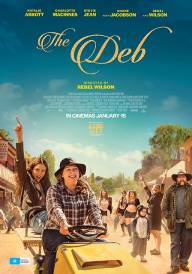Rebel Wilson Cats
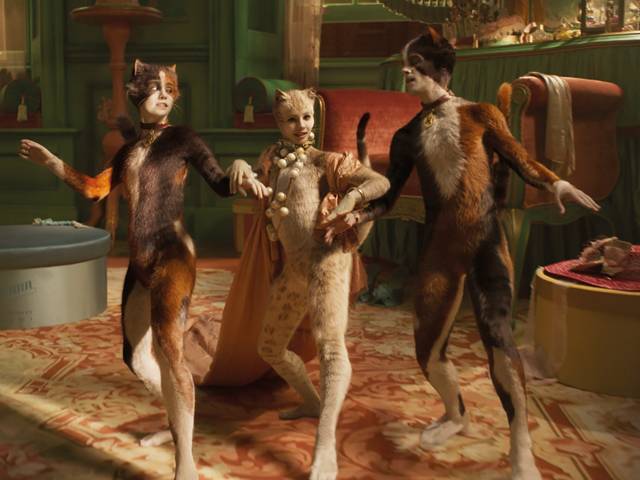
The Most Joyful Event of the Holiday Season
Cast: Ian McKellen, Rebel Wilson, Ray Winstone, Judi Dench, Idris Elba, James Corden, Jennifer Hudson, Taylor Swift, Francesca Hayward, Jason Derulo, Laurie Davidson
Director: Tom Hooper
Genre: Animation, Comedy
Rated: PG
Running Time: 102 minutes
Synopsis: A tribe of cats called the Jellicles must decide yearly which one will ascend to the Heaviside Layer and come back to a new Jellicle life.
Cats
Release Date: December 26th, 2019
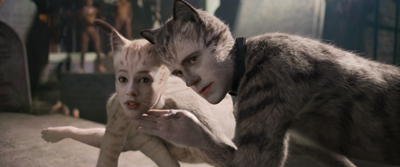 The Backstory
The Backstory
Act I
Genesis
Tom Hooper was approached by producer Debra Hayward about a film version of Cats in 2012, in London, where Hooper was in post-production on his film adaptation of the stage musical Les Misérables for Universal Pictures, which was nominated for eight Oscars®, including Best Picture, and won three. The possibility intrigued him. "I just thought what a shame it would be if I never did a musical again, because I'd learned so much doing Les Mis," Hooper says.
As a boy, Hooper had seen Andrew Lloyd Webber's "Cats" on the stage and had been wonderstruck by it. "I first saw Cats when I was 10 years old, and I have such a vivid memory of what an extraordinary experience it was," Hooper says. "I felt I was being initiated into the secret world of cats. It felt like I was being given this privileged access to this other way of looking at the world."
In the original 1980s stage musical, "Cats" takes place on the night of the annual Jellicle Ball, when Old Deuteronomy, the elderly leader of the cats, will choose one cat to ascend to the Heaviside Layer to be reborn into a new life. Cats competing to be chosen must perform a song about themselves for Old Deuteronomy. But the sinister outlaw, Macavity, in his determination to be chosen, tries to disrupt the proceedings by making the cats that stand in his way magically disappear, leaving him the only contender. When Old Deuteronomy still refuses to make Macavity the chosen one, Macavity takes Old Deuteronomy, too. Just when all seems lost, magical Mr. Mistoffelees uses his powers to conjure Old Deuteronomy from captivity. The musical ends with Grizabella the Glamour Cat, a formerly shunned member of the tribe, performing her song "Memory," and Old Deuteronomy choosing her as the cat who will be reborn.
The longevity, record-breaking success and global appeal of "Cats" was undeniable, but as a potential film adaptation, it presented some challenges and opportunities. The show has little narrative structure in the traditional sense. The stage production is essentially a series of poems put to song that become stepping-stones for spectacular dance and music sequences. It also features actors in cat costumes and exaggerated feline makeup, neither of which would quite work on film. But the potential to create a new, extraordinary cinematic experience was there.
Hooper had worked with Debra Hayward on Les Misérables and after that film was finished the two began developing ideas for how to adapt Cats. "We had a meeting with Andrew Lloyd Webber after which we all decided to move forward with it," Debra Hayward says. In a bit of serendipity, the rights to "Cats" were controlled by Universal Pictures, with which Hooper and Hayward had just made Les Misérables. Even better, Hayward's fellow producers on Les Mis, Working Title's Eric Fellner and Tim Bevan, were on-board to adapt "Cats" for a film, as well. "Everyone with whom we had made Les Mis"the head of the studio, Donna Langley, Working Title"came back together for Cats," Debra Hayward says. "It was like getting the band back together."
Les Mis had been the first musical film Working Title had produced, and co-chairmen Eric Fellner and Tim Bevan understood the appeal of a film that could transport audiences into a magical new world. "Musicals have an enduring family appeal," Eric Fellner says. "They take you away from the real world in a similar way that superhero movies do. Musicals captivate audiences through unbelievable, dream-like scenarios."
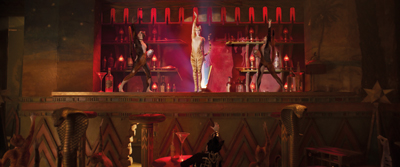 Fellner also saw that the poetry-based elements of the stage musical could be a benefit more than a challenge. "That's what makes this musical extraordinary," Fellner says. "There's very little reworking or rewriting, and we were proud to be able to carry that through this film. The legacy of T.S. Eliot and his love of writing is inherent in the DNA of this entire production." Fellner also understood why Hooper was the ideal filmmaker to adapt it for the screen. "Tom Hooper can create narrative and emotion out of stories that often don't have obvious narrative or emotion," Fellner says. "That's the kind of director that you want for a project like this. He is able to bring out the story and emotion, while combining the musical elements beautifully."
Fellner also saw that the poetry-based elements of the stage musical could be a benefit more than a challenge. "That's what makes this musical extraordinary," Fellner says. "There's very little reworking or rewriting, and we were proud to be able to carry that through this film. The legacy of T.S. Eliot and his love of writing is inherent in the DNA of this entire production." Fellner also understood why Hooper was the ideal filmmaker to adapt it for the screen. "Tom Hooper can create narrative and emotion out of stories that often don't have obvious narrative or emotion," Fellner says. "That's the kind of director that you want for a project like this. He is able to bring out the story and emotion, while combining the musical elements beautifully."
Act II
Screenplay
Working with Hooper, screenwriter and playwright Lee Hall began tackling the adaptation, weaving the lyrics into a narrative structure. Hall had written the screenplay for the film Billy Elliot and then later wrote the lyrics for the stage musical adaptation, so he had essentially done a process like this before, only in reverse.
"What is great about Cats are these fantastic musical numbers," Hall says. "It's one great song after another. It has a structure but not a story. The story of a film needed to have a journey, so we literally started thinking about a journey in London. Tom and I were writing in Soho and would walk around those streets as we were talking about this problem. And then one day we realized the journey we were on was fascinating, through the little alleys and streets of Soho and central London, and that we were essentially in Eliot's London. That was the first step."
Unlike the stage musical, which was set in the 1980s, Hooper's Cats would be set in London in the 1930s, when Eliot would have been living and writing there. This one decision would eventually shape every design aspect of the film and resonate narratively and thematically on multiple levels. "The 1930s was sort of the end of the music hall era," Hooper says. "In that period between the wars, the music hall review show was this dying art form. Our genius production designer Eve Stewart found these wonderful photographs of Soho and the West End from the time, full of music hall that were falling apart. And in some sense, if you think about the form of Cats, it's kind of a musical review. You have all these different styles of performers coming to entertain the audience. I know from Andrew Lloyd Webber that some of the poems that T.S. Eliot wrote were based on the rhythms of music hall hits, so there seemed to be something very evocative about this cabaret-style review structure, where all these cats are performing to prove they're worthy, set at a time when that form of theater was passing away."
The next step was finding a character that audiences could latch onto. "Once you start thinking about journeys you start thinking about fairy tales and their classic storytelling structure," Hall says. "So, I then thought, what if we follow one cat through the whole thing, and that's how we came up with the idea of following one young cat, Victoria, on a coming-of-age journey through London."
The character of Victoria was featured in the original stage musical and was a principal dancer in the show, but she was not a prominent character; she didn't even have her own song. So, the filmmakers expanded the character to serve the narrative. "Victoria becomes the conduit into our world of Cats," Debra Hayward says. "It's in that tradition of fairy stories"Alice going down the rabbit hole, Dorothy going up through the tornado or Wendy out the window with Peter Pan."
Victoria would become the audience's guide into the incredible world of Cats. "After Victoria is thrown away in a sack, she enters this night-time world of the Jellicles and is taken on an odyssey," Debra Hayward says. "Along the way she meets all these wonderful, amazing characters."
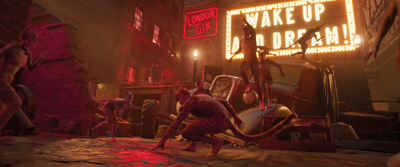 As part of her character expansion, Hall and Hooper gave Victoria a narrative partner in the form of Mr. Mistoffelees, a prominent character in the stage show whom they modified for the film. "It was creating the sense of somebody Victoria might go on this journey with," Hall says. "Mistoffelees is sort of a fun, bumbling fool who comes good in the end; Victoria's jejune, finding out about her own sensuality."
As part of her character expansion, Hall and Hooper gave Victoria a narrative partner in the form of Mr. Mistoffelees, a prominent character in the stage show whom they modified for the film. "It was creating the sense of somebody Victoria might go on this journey with," Hall says. "Mistoffelees is sort of a fun, bumbling fool who comes good in the end; Victoria's jejune, finding out about her own sensuality."
Victoria finds herself in an extraordinary world of incredible characters who take her in and teach her about their world; but she in turn teaches them, too. By using the character of a shunned cat, Grizabella, and Victoria's reaction to her, Hooper and Hall were able to create a central emotional arc to match their narrative one. "Cats is really about the power of community," Hooper says. "It tells the story of this excluded cat Grizabella who's on the margins of society, almost as if she represents someone in a state of homelessness. We see our tribe of cats viciously excluding her. It's the innocent outsider, Victoria, who challenges the prejudice of the group. She shows that we are stronger when we are inclusive through the act of forgiveness, that when we include people on the margins of our society our society is stronger. So, at the center of this entertaining, fun, comedic, fantastical and transportive musical is a timely story about the importance of inclusion and community, forgiveness and redemption."
Act III
Vision
"I'm a great believer in live performance"live singing, live dancing," Tom Hooper says. "If I have a strength as a director it's about capturing lightning in a bottle. Just like with Les Misérables, the visuals for this film support live performance, so you keep that incredible connection with the actor."
Hooper's vision, above all, was to transport and thrill audiences the way he had been by the stage production as a kid, but now elevated into an immersive, entertaining, cinematic extravaganza. "I want to give that experience to the modern equivalent of the 10-year-old me and to the parents and grandparents of that 10-year-old," Hooper says. "What's extraordinary about Cats is that it continues to touch every generation. People have this incredible love of the music, so we are staying true to this brilliant score that I still think is one of Andrew Lloyd Webber's best." The film, though, allowed Hooper and team to amplify and expand on areas that a stage production could not. "We can do dance on a bigger scale, on real sets and in an ever-changing London landscape," Hooper says. "Whereas the show was limited to everything being set on the Wasteland, the first half of the film is this wonderful journey through Soho in the 1930s. So, the film presents dance in a much more epic and realistic context."
"Epic" and "Realistic" were key words for Hooper's vision, and that extended to the scale and look of the sets and to the look of the cats themselves. "In a CG world, you can have an actor or performer do anything," Debra Hayward says. "They can jump from the top of a building and land on the street. What Tom was keen on with the dancers was to see how far he could push the dancers in a cat-like way without having to resort to huge visual effects. Live performance was really important to him."
Hooper's vision would eventually attract some of the most extraordinary artists, in front of and behind the camera, ever assembled for a musical film, and extend from the fields of music and dance to cinematography, visual effects, production design, costume design, sound and beyond.
"It's a huge responsibility to take something that is so beloved and so mature as a piece of work and recreate it for the screen, and it was a responsibility that we all took incredibly seriously," Debra Hayward says. "We spent a long time during the research and development stage working out how to retain the integrity of the show and of the score, while finding a new way to tell the story. It was exciting for us, though, because nothing like this has been done before."
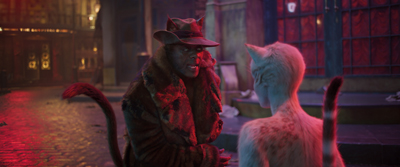 The Characters
The Characters
Triple-Threats Required
Casting Cats
"One of the great things about Cats, because of the nature of the show, is that it lends itself to fantastic casting," Debra Hayward says. "The characters are incredibly well-defined. In the original T.S. Eliot poems, there are loads of clues as to their personalities, how they live, who they are. So, we basically went back to the poems, looked at those characters and we started thinking about who would best fit those roles."
The filmmakers enlisted the talents of experienced casting director Lucy Bevan (Fast & Furious Presents: Hobbs & Shaw, Murder on the Orient Express) to cast the film, and so began a long and intense two-year process of searching for dancers that could also sing and act, and actors who could also sing and dance. For producer Eric Feller and his partner at Working Title, Tim Bevan, it was unlike anything they'd experienced before in their storied careers. "Tim and I aren't used to casting our films with dancers or singers, so this film presented an exciting new challenge," Fellner says. "Alongside our brilliant casting director, Lucy Bevan, we scoured the world for not only notable talent, but also the greatest practitioners of song and dance." Adds producer Debra Hayward: "We auditioned actors and singers from around the world; we auditioned dancers from every walk of life, every dance school, every school and professional organization."
The result, though, is near-peerless in the history of musical film. "Going to work every day with this kind of cast," Tom Hooper says, "it was just phenomenal."
Victoria
Francesca Hayward
Victoria, the youngest of the cats, is new to the tribe and serves as the audience's introduction to the world of the Jellicle cats. Victoria has been thrown into a world that she doesn't understand and in which she must adapt to. While she is kind and empathetic, she also has an inner fire and strength. "Victoria is the conduit throughout the story," Debra Hayward says. "Whoever played her needed to be able to sing, to dance and to act at a world-class level. There are not many of those people that exist anywhere in the world, never mind in the U.K."
The search for that person eventually led them to Royal Ballet principal dancer Francesca Hayward, who had never appeared in a film before. "We knew she was the best dancer in the country, but what was really exciting was that she was willing to come in and audition and to sing," says casting director Lucy Bevan. "She came in and auditioned for Tom and performed a ballet solo, and it was one of the most inspiring moments of my career. It was a beautiful moment."
And very memorable. "That audition has become the stuff of legend," says Debra Hayward. "Francesca did this tiny little piece from Giselle, a classical piece which Tom then directed in a different way. Her virtuosity, her grace and her brilliance just blew us all away."
Says Tom Hooper: "From day one, Francesca had a total instinctive command of the film camera that allowed her to stand shoulder-to-shoulder with Judi Dench and Ian McKellen, these incredibly experienced geniuses of their craft. What I found fascinating, and unexpected, about working with her and the other dancers was how, even when the camera went in close, how everything they were doing in the dance was being intensified and expressed beautifully through their faces as well. It was almost an embarrassment of riches."
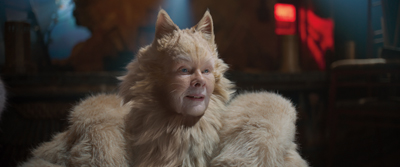 Producer Eric Fellner was equally dazzled. "We knew Francesca was a big star in the world of ballet, but when the camera came out on day one and the lens was on her face, it was as if a million light bulbs went off," Fellner says. "It was quite astonishing. She is not just a performer who can dance and sing beautifully, she is a bona fide actress. I think it's going to be quite amazing when people discover that someone they've never heard of is as powerful, confident and brilliant as Francesca Hayward is in this film."
Producer Eric Fellner was equally dazzled. "We knew Francesca was a big star in the world of ballet, but when the camera came out on day one and the lens was on her face, it was as if a million light bulbs went off," Fellner says. "It was quite astonishing. She is not just a performer who can dance and sing beautifully, she is a bona fide actress. I think it's going to be quite amazing when people discover that someone they've never heard of is as powerful, confident and brilliant as Francesca Hayward is in this film."
At the beginning of the film, Victoria has been abandoned in an alley and is introduced to the fantastical world of the cats on the night of their annual ball. Though abandoned, Victoria is not a victim. She needs help but she is not helpless. She has a kind heart and an inner strength.
"When we meet her, she's still dealing with the pain of that abandonment, but she's taken on a journey while meeting many new cats over the course of the story," Francesca Hayward says. "Victoria quickly realizes that every cat she meets along her journey is practicing their audition pieces for the Jellicle ball. Their auditions are their big moments to prove themselves to Old Deuteronomy, played by Judi Dench, and to be chosen to go to the Heaviside Layer. Along her journey, she realizes that with this group of cats is where she's meant to be."
Victoria is drawn to one particular cat, Grizabella (Jennifer Hudson), who has been shunned by the others. Victoria comes to Grizabella's aid when the other cats mock her. She recognizes Grizabella's worthiness and teaches the cats to be caring and inclusive, starting with accepting Grizabella back into the tribe. "Victoria and Grizabella form a connection because they've both been hurt and have experienced trauma," Francesca Hayward says. "Victoria is younger than Grizabella, so she has the opportunity to create a better life for herself, and she tries to help Grizabella to see past her pain to do the same."
Old Deuteronomy
Judi Dench
Old Deuteronomy, the matriarch of the tribe, has been reimagined as a female cat instead of the patriarchal character from the original show. She's strong, wise and it's been rumored that she has had 99 lives. The filmmakers' first and only choice for the role was the legendary Judi Dench. "I decided to re-gender Deuteronomy because, in 2019, the idea that the authority figure has to be a man didn't feel like the right way of looking at things," Tom Hooper says. "And Judi Dench walking onto the set, in her extraordinary way, walking into the street in her first scene and being surrounded by her community of these young actors and dancers, immediately anchors the movie and anchors that scene. Judi has a genius ability to, with the smallest expression, create incredible magic in drawing her character."
Dench also, it turned out, had a fascinating connection to the original London stage musical. "I was cast as Grizabella and The Gumbie Cat for the stage show in 1981," Dench says. "The Gumbie Cat did a lot of tap dancing throughout the show, and just before we opened, I snapped my Achilles' tendon while rehearsing. Our director Trevor Nunn and Andrew Lloyd Webber spoke to me and said that I could still play Grizabella since her character doesn't dance the way Gumbie does. On my first day back, we had moved to the New London Theatre, and I fell off the ramp, because I was still in a plaster [cast], while I was walking up to the stage. At that point, I realized, if I couldn't get up onto the stage, I couldn't do the show. I thought that was my history with Cats, but then this project came along. Tom Hooper reached out to me about it, and my involvement with Cats has come full circle."
At the annual Jellicle ball, Old Deuteronomy decides which cat will be reborn. "Deuteronomy is the oldest cat who rules over all the other cats," Dench says. "She is the judge who chooses which cat will be able to go to the Heaviside Layer. She ultimately helps Grizabella get past the rejection that she's faced to become accepted by the Jellicle cats again."
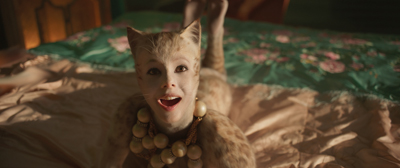 Dench had been interested in theater, dancing and musicals from a young age. "I wanted to be a dancer when I was very young," Dench says. "My parents were simply wonderful and took us to the theater to see plays and musicals all the time. A good, strong story that's been enhanced by music and dance will just send the audience out on a high. I remember taking my daughter when she was very young to see 42nd Street, and the curtain went up about four feet from the ground and we saw everyone tap dancing. She was completely ecstatic, and she has a love for musicals like I have now."
Dench had been interested in theater, dancing and musicals from a young age. "I wanted to be a dancer when I was very young," Dench says. "My parents were simply wonderful and took us to the theater to see plays and musicals all the time. A good, strong story that's been enhanced by music and dance will just send the audience out on a high. I remember taking my daughter when she was very young to see 42nd Street, and the curtain went up about four feet from the ground and we saw everyone tap dancing. She was completely ecstatic, and she has a love for musicals like I have now."
The Oscar®-winning actress was excited by the fresh take on the classic music and was equally as enthusiastic about the performances in the film. "People are very fond of the music of Cats," Dench says. "This film has taken that music and enhanced it with a very well-thought-out story about the relationship between Victoria and Grizabella and the journey that each of their characters goes through. The dancers were simply beautiful to watch. Their discipline and detailed observation about how cats move was sublime."
Macavity
Idris Elba
Macavity, played by Idris Elba, is the infamous outlaw criminal in the cat world"compelling, charismatic and deeply dangerous. "Macavity is a cat that you know has been in a few fights," Elba says. "He's a trickster. He's charming one minute and then horribly desperate and insecure the next. He sticks his nose into almost everything."
Macavity's ultimate goal is to ascend to the Heaviside Layer, and he will do whatever it takes to get there, even if that means kidnapping various members of the tribe in the process. He only has one of his nine lives left, so he needs to show Old Deuteronomy that he's worthy of being chosen. He performs his song, "Macavity," with his seductive partner-in-crime, Bombalurina (Taylor Swift). "The 'Macavity' song is an iconic show piece," Elba says. "The performance is Macavity's opportunity to show his talent in hopes of being chosen to go to the Heaviside Layer. The song has a very old-school Hollywood sound, and it was a joy to be able to work with Taylor Swift on this number."
Hooper found them to be a magical duo. "I'm a huge fan of Idris, and I've wanted to work with him for such a long time, and the chemistry between them on set was fantastic," Tom Hooper says. "Our choreographer, Andy Blankenbuehler, excelled himself creating an incredible number for Taylor and Idris in an amazing storytelling frame for their characters."
Elba's career has expanded from not only acting, but music as well, which has been an interest of his since early in his life. "My journey with music started when I was young, when I listened to a lot of music and my dad and uncle were music collectors," Elba says. "I was in the National Youth Music Theatre when I was a kid and I played Jule in Guys and Dolls. You can evoke certain emotions through songs that you might not be able to do with acting, which makes musicals quite special."
For Elba, Macavity was a unique role, and he has high expectations as to what audiences will take away from the film. "It's undeniable that this is one of the greatest musicals there has ever been," Elba says. "I think the spectacle and scale of this film will continue that legacy. It's the type of movie that people will want to have a copy of to watch at Christmastime every year.
"As an actor and director, working on this film was a great master class in how to pull together a production of the most enormous scale," Elba continues. "Tom had a very specific vision for this film and it was clear that he had extensive musical knowledge. He approached me for the film because he wanted to see me in a role that was outside my comfort zone, and we managed to make Macavity into a character unlike anything I had ever played before."
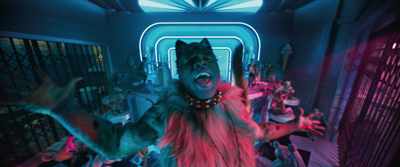 Grizabella
Grizabella
Jennifer Hudson
Grizabella, who is also known as Grizabella the Glamour cat, is a cat who is isolated and alone, but she possesses an inner grace and strength. She is mocked by the other cats and has been excluded from the tribe, so she dreams of bygone days when she was young and adored.
Grizabella performs one of the most notable songs from the original Broadway production, "Memory," and the filmmakers looked no further than iconic singer and actress Jennifer Hudson (Dreamgirls) to bring her to life. "Grizabella has a presence that changes the tone of any room she walks into," Hudson says. "She was once the cat that brought all of the cats together in happiness and celebration, but now she's no longer welcome. I sat down with Tom Hooper before we started shooting and we dissected the character of Grizabella. That helped me get an idea for what I felt Grizabella would look like and how she should move. We discussed the details of her past and how that would affect the heaviness in her walk or the brokenness in her facial expressions. We wanted people who saw her on-screen to think, 'What happened to her?'"
For Hooper, it was Hudson's artistry as an actress, as much as her powerhouse voice, that made her the ideal choice for the role"and to sing that song. "We went through a fantastic rehearsal process working on the emotion behind the song in preparing her for the day," Hooper says. "I'm sure she was nervous on the day we filmed it, but she gave such an intelligent and incredible performance that I knew I had cast the emotional centerpiece of the film."
So, how does one go about performing a song that has been recorded by more than 150 artists worldwide? "'Memory' is the heart of the story of Cats and of Grizabella's character," Hudson says. "It's such a classic and iconic song. I wanted to reinvent it while also honoring the original. Andrew Lloyd Webber was very trusting and encouraged me to bring what I felt through my character to the song. I got emotional every time I practiced the song. It was as if the music spoke to me."
One of the quintessential relationships that forms in the film's story is between Grizabella and Victoria, played by Francesca Hayward. Victoria expresses a kindness that Grizabella hasn't seen for a long time, which helps Grizabella regain her confidence in herself. "Victoria is a new, young and innocent cat who has a connection to Grizabella," Hudson says. "Grizabella has become completely scarred and doesn't feel like she can trust anyone, but Victoria shows her a bit more mercy and friendliness than the other cats have. Victoria is young, full of life and has a bit of leverage among the cats, so she uses that leverage to help build Grizabella's confidence in her pursuit of the Heaviside Layer."
Hudson explains how she worked alongside the dancers to create unity in the performances together. "Grizabella doesn't dance in the film, but the choreography is so central to the story," Hudson says. "Most of the language in the film is done through song and dance, and the body language that the dancers evoke tell specific stories. When I sang, the dancers and I fed off each other and helped to intertwine the two mediums together. I'm just glad that Grizabella didn't have to dance because it took the most elite dancers and choreographer to be able to pull the dance numbers off.
"I come from a very musical background, so music has always been the magnet that draws me to the projects that I want to be a part of," Hudson continues. "Cats is a beautiful tribute to art. So many forms of art"poetry, music, dance, acting"are celebrated and captured at their greatest levels in this film."
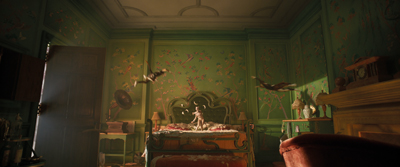 Jennyanydots
Jennyanydots
Rebel Wilson
Jennyanydots, portrayed by Pitch Perfect's Rebel Wilson, dreams of a life in show business. She can be mistaken for being lazy because she sleeps all day, but at night she's a bundle of activity as she teaches choreography to the mice and the cockroaches who live in the kitchen. "Jennyanydots is a Gumbie Cat who has been living in her owners' kitchen for her entire life," Wilson says. "She gets a bit bored, so she creates shows with the mice and cockroaches that she finds in the house. She's like a frustrated choreographer who has bigger dreams than being contained to the kitchen."
Hooper and Wilson found they could mine ample humor from that idea. "We loved this idea that Jennyanydots was basically a domesticated cat stuck in a basement kitchen," Hooper says. "But one who really needs a stage to express her creativity."
Wilson, like her castmates, had an early introduction to musicals, though she wasn't the first person in her family to get into showbiz. "The first musical I saw was 42nd Street because our family's dog had auditioned to be in the show," Wilson says. "He got to callbacks, but then pooped on the stage, so he obviously didn't get the role. My mom really wanted to see what dog did get cast in the production, so we all went as a family to see the show. I thought the singing and dancing was spectacular and I've been hooked ever since."
Wilson brought her love of theater along with her the first time she visited London. "The first time I went to London, I was 21 years old," Wilson says. "The first thing I did was go to the TKTS stand to buy tickets to Cats and Starlight Express, which were both Andrew Lloyd Webber's musicals. I was a student, so I couldn't really afford good seats, but I just remember loving them both. I was amazed at the physicality of the performers and the details in the costumes."
While staying true to the character, Wilson, director Hooper and composer Lloyd Webber worked closely together to ensure that Jennyanydots was as they had envisioned. "I was the first performer that Andrew Lloyd Webber came in to see filming on set because my number was shot first," Wilson says. "He was very particular about the tempo and the need for 'The Old Gumbie Cat' to have a certain groove to it. In the stage show, it's sung by three girls as a three-part harmony, so I did a bit of an amalgamation of those three parts in this film's version. Tom and I wanted to add humor to my character while staying true to Andrew's amazing music and T.S. Eliot's poems. Because the singing was all live, I tried a lot of different singing techniques to figure out what would make Jennyanydots the funniest."
Wilson deeply admired her director's vision and the amount of thought that went into the production. "Before we started filming, Tom gave a passionate speech about seeing the Cats musical when he was 10 years old and how it changed his life and inspired him to want to make a movie out of it," Wilson says. "I thought to myself, 'Wow, this isn't something that just came to him; this is a real passion project that he's been working towards for years.' I was thrilled to be a part of that, and Tom was so positive and collaborative throughout the entire process."
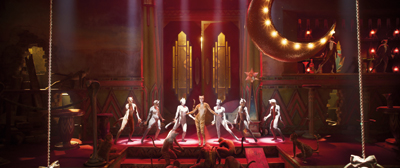 Bustopher Jones
Bustopher Jones
James Corden
James Corden, now perhaps best known for his late-night talk show, won a Tony in 2012 for his Broadway and West End performance in the smash comedy One Man, Two Guvnors, and has starred in the film musical Into the Woods. In Cats, he plays Bustopher Jones, the epicure and glutton of the Jellicles. Despite his past experience, Corden's work on Cats proved quite different than his previous work on any musicals. "In Into the Woods, parts of the performances were live, and parts were pre-recorded," Corden says. "Cats was entirely live performances, but the only instrument that played alongside our singing was the piano at the time. While we knew they would add additional orchestral music into it, we had to feel it and really commit to singing, even without those added instruments."
Bustopher is a dandy, an impeccably groomed cat with a taste for the finer things in life, including great food. "Bustopher Jones is a big, fat cat of St. James," Corden says. "He knows he's not skin and bones and he owns it. He's very posh and extravagant, but equally savage in his pursuit of food. He's always looking for a good time. He's also very light on his feet and has a real finesse about him. Tom and I thought we should find as many moments of comedy as we could for the character. I told Tom that I wanted to be as physical in the role as possible and Tom agreed, saying he never wanted Bustopher to be still."
Having grown up loving theater himself, Corden saw Hooper's passion and commitment shine through his directing on this film. "Tom understands the spectacle of Cats, which revolves around the dances and performances," Corden says. "There were certain scenes that many directors would have opted to use CGI, but Tom was completely committed to the notion of the scenes absolutely happening in the moment. This film combines performers putting on a show, which is one of the oldest forms of entertainment, with ground-breaking technology, which was incredibly exciting to be a part of. It's completely original and that's what people want to see. There's nothing else like it and there never will be."
Gus the Theatre Cat
Ian McKellen
Gus the Theatre Cat is an elderly cat who has lived his life in the theater, playing all the great cat roles. His greatest role was 'Firefrorefiddle, the Fiend of the Fell,' but he has since become frail and hard of hearing. Gus, who is deeply admired by the other cats, is portrayed by Ian McKellen of The Lord of the Rings trilogy. McKellen is similarly admired by his co-stars and filmmakers alike. "There was no one better than Ian McKellen to play Gus the Theatre Cat," producer Eric Fellner says. "We called him and talked to him, Tom met with him and he said, 'yes.'" His co-star Judi Dench adds: "Ian and I have known each other for years and have done many plays together," Dench says. "The first film we did together was just last year in Kenneth Branagh's All Is True. It was very lovely to work with him again so soon."
For Hooper, the opportunity to work with McKellen after all these years was a thrill. "I've wanted to work with him all my life," Hooper says. "To get this chance to work with him in his 80th year was one of my great dreams. He is a genius, a wonderful man and a wonderful person. And there was something incredibly moving about him playing Gus the Theatre Cat, and effectively evoking through this character a life on the stage." To watch McKellen and Dench sing together was a once-in-a-lifetime moment for him. "Having these two colossi of British film and theater acting opposite each other talking about, through the song, their life in theater and in drama was moving and very special to me," Hooper says.
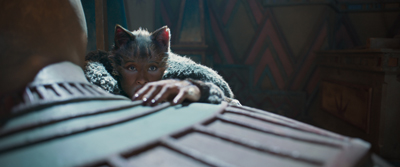 Mr. Mistoffelees
Mr. Mistoffelees
Laurie Davidson
Mr. Mistoffelees, a magician-in-training who is still discovering his own powers, is played by Laurie Davidson, perhaps best known for his role as Shakespeare in the 2017 TNT series Will. Mistoffelees is popular with the other cats and has a crush on newcomer Victoria. "The Jellicle cats are quite an intimidating bunch," Davidson says. "Victoria is thrust into this terrifying world where she knows nothing about these other cats, and Mistoffelees has a softer energy than the other cats. Mistoffelees is spellbound by Victoria and sees an innocence in her that he sees in himself. Throughout the story, Mistoffelees ends up being the one who's always by Victoria's side and the one who she seeks comfort from."
Mistoffelees is one of the more clumsy and shy cats of the group and doesn't have much faith in his magical abilities, but, little does he know, his powers will prove useful in unexpected ways. "Mistoffelees likes to do magic tricks, but they often go wrong because he gets distracted or embarrassed," Davidson says. "He doesn't have a lot of confidence in himself, but during his number, Munkustrap and the rest of the cats try to help lift him up."
While Davidson didn't have any formal dance background before he joined the film, he was certainly whipped into dancing shape quite quickly, and gained some friends along the way. "The best part about working on this film was the relationships that we formed," Davidson says. "The three months of rehearsal allowed us to bond and become comfortable with each other. I had my first ballet class sandwiched between Robbie Fairchild, who plays Munkustrap, and Francesca Hayward. I had never done ballet in my life, and I think it's safe to say that I didn't hold my own, but, hey, I tried my best. Over the course of the rehearsal process, I gained so much more control over my body than I had beforehand. I have a background in sports, but I learned how to move with a cat-like fluidity that I wasn't used to."
Like many of his castmates, Davidson recalls Hooper's clear vision for the film from the onset. "When I met Tom for the first time, he was very clear about what he wanted in the film," Davidson says. "He was creating something new, while also honoring the musical. He wanted to tell a story that explored the characters further than the stage musical did. He has such vivid memories of watching the musical as a child, and because of that, he brought so much genuine enthusiasm to the project. He did such a great job at finding the purity in the stories of the characters."
Bombalurina
Taylor Swift
Bombalurina is Macavity's powerful and beautiful partner in crime. She is full of personality and attitude. She loves to be the center of attention and makes a grand entrance into any room she steps. She's the leader of Macavity's gang and puts all the other cats in a trance using her catnip. In the original show, the song "Macavity" is performed by two cats, but Hooper wanted to expand the role of Bombalurina as Macavity's partner in crime, and the number was totally reconceived for one performer, which gives it a new and different impact for the film. The role demands a performer who can hold the attention of the audience by sheer force of personality and with immense singing ability, as well as being able to act and dance, and the filmmakers couldn't think of anyone better for the part than the multi-platinum, Grammy Award-winning, megastar Taylor Swift. "There was only one name that we wanted for Bombalurina," Eric Fellner says. "Tom had met Taylor during the casting process for Les Mis and when this opportunity came up, he reached out to her and we were all so glad when she said, 'yes.'"
Hooper was delighted that he and Swift had this second chance to work together. "I've always wanted to work with her," Hooper says. "So, to be able to get in touch early on in this process and have this character in mind, and finally have the chance to work with and direct her as an actress, as well as a singer and a dancer, was such an amazing experience."
Rum Tum Tugger
Jason Derulo
Rum Tum Tugger is a handsome and charismatic cat who is adored by the younger female cats. He's a popular member of the Jellicle tribe and likes to party. The part is played by platinum-selling singer and dancer Jason Derulo in his first film acting role. "I've always wanted to dive into film, but it was imperative to me that whatever my first film was had to be the right decision," Derulo says. "I thought the role of Rum Tug Tugger was the perfect opportunity because it was challenging and allowed me to experiment with the character."
Rum Tum Tugger has a wild, fun and electric energy about him, but he is also very indecisive. "Rum Tug Tugger provides comedic relief in the movie," Derulo says. "He's always going from one extreme to the next and can never make up his mind, which also makes him endearing. He can't commit to any decisions, which unfortunately keeps him from experiencing the joys in his life."
While Derulo isn't a stranger to song and dance, he was glad to be able to get back to his dancing roots alongside choreographer Andy Blankenbuehler. "Andy is a brilliant choreographer," Derulo says. "He had a large picture in his head about what the numbers should look like, and by the end of each day, they turned into something a bit different. He had us constantly trying new things and learning moves on the spot. He's a great artist because he was able to morph the choreography based on everyone's strengths. I went to school for musical theater, so I studied ballet, jazz and tap dancing. It was great to reintroduce myself to those genres and to learn some new steps."
For Rum Rum Tugger's solo number, Derulo reflected on the differences between performing on set versus at concerts. "'Rum Tum Tugger' is a stand-alone track and is a little bit different from the other songs in the film," Derulo says. "It's funky and fun, but also explains how Rum Tum Tugger struggles in life. Performing for film is different from performing live because when you perform your heart out, you usually expect applause, but in this case, we'd just cut when we finished. But what's similar is the fact that I dove into the music wholeheartedly and left it all on the floor."
One of the main takeaways that Derulo had from his experience working on the film was the fresh perspective that Hooper had as a director, and how he brought his lifelong vision to the screen. "I spent a lot of time sitting next to Tom and learning from him," Derulo says. "Watching how he directed gave me a different perspective and will probably change the way that I make music videos moving forward. The average music video is two-dimensional, whereas this movie was shot in a full circle, bringing the audience deeper into that world. The film encapsulates all the things we know and love about the stage musical while bringing a whole new flavor to it. It's a ground-breaking film using never-before-seen technology, and I think it will change the way that people view musicals."
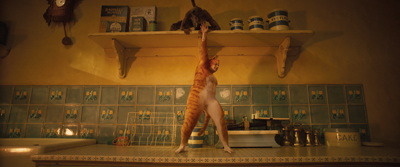 Munkustrap
Munkustrap
Robbie Fairchild
Munkustrap, played by Robbie Fairchild of Broadway's An American in Paris – The Musical, is the leader of the Jellicle cats and the heir apparent to Old Deuteronomy. He protects the younger cats and guides Victoria into the new world of the Jellicles. He's dignified and energetic, which makes him a great MC of the Jellicle ball. "Munkustrap is very compassionate and wise," Fairchild says. "He loves watching his fellow felines shine in their own way, and they respect him for that. He's somewhat of an old soul, yet finds it thrilling to experience Victoria's journey on the night of her first Jellicle Ball. Munkustrap sees the special qualities and potential in Victoria and does his best to protect her from danger."
Having previously performed as a principal dancer with the New York City Ballet, Fairchild had no problem perfecting cat-like senses through dance. "I've dedicated so much of my life to dance and to telling stories through movement," Fairchild says. "This film is such a perfect combination of narrative storytelling through song and dance, the two means of storytelling that feel very at home for me. The choreography in this film is a hybrid of human and cat movement. We couldn't go too 'cat,' because we would lose some of the dance, but if we went too 'human,' it just didn't work. So, we had to find a perfect balance of the two. Andy and Tom did a great job finding this clarity in the movement."
As with Francesca Hayward, also a professional dancer, Hooper found that Fairchild had a natural ability to communicate through the camera. "The thing I'm most proud of discovering how these talents can be so interdisciplinary," Hooper says. "We seem to have smashed out the divisions between all these art forms and found these incredible people who have the capacity to sing, dance and act."
Plato and Socrates
Les Twins (Larry and Laurent Bourgeois)
Famed hip-hop dancers Larry and Laurent Bourgeois (Men in Black: International), professionally known as Les Twins, joined the other many talented dancers in the film as Plato and Socrates, respectively. But Hooper kind of had to persuade them, just a little. "I've never had an audition in my life where someone turned up and basically made it clear that, you know, I was auditioning for them," Hooper says, with a laugh. "Larry was basically like, 'We've never danced in a film before, so you've got to convince us why your film is the one we're going to dance in the first time.' So, I was pitching them for half an hour and then one of them just suddenly started to move in this incredible way, and I was like 'Oh my God, that cat is incredible.' Then I was even more determined to persuade them! Eventually they were like, 'Okay, we dance now.' They put on the music and each one gave a performance that just blew my mind."
When they got to set, though, it was the twins' turn to have their minds blown. They were instantly awestruck with the size and scale of the sets of the film. "You know the feeling you get the first time you go to Disneyland?" Larry Bourgeois says. "That's exactly how I felt when I walked onto set the first time. You wouldn't have even needed to know the story because the sets told stories themselves. It was beyond anything we'd ever been a part of. It was…" Laurent Bourgeois finishes: "Iconic."
Les Twins say they had no hesitations about joining the film. "Being a part of Cats was a huge responsibility," Laurent Bourgeois says. "We had never been in a production this big before, but we trusted that Tom Hooper would be a great leader." Larry continues: "Our mom doesn't even speak English, but she knows a song from Cats. We were excited to be a part of something so iconic that our mom would love."
Larry and Laurent have competed in dance competitions around the world and used their dance experiences to enhance the outcome of their roles. "The great thing about the dancing in this movie is that it's all real," Laurent Bourgeois says. "All of the dancing that you see is actually us. We controlled how the visual effects were put on later through our dancing and our movements." Larry adds: "Movement is the most important kind of language. Even at times when there are no words to describe your emotions, you can express those emotions through dance."
Cassandra
Mette Towley
Cassandra is portrayed by Mette Towley, a dancer who has been featured in music videos for Rihanna and this year's Hustlers. Cassandra is an outspoken member of the Jellicles and defends the tribe, first and foremost. "Cassandra has a strength and a voice that demands attention," Towley says. "She questions the others and pushes their buttons. When Victoria shows up, Cassandra questions what she wants from the group because she's protective of her tribe. She's a strong leader of the Jellicles and she wants success for everyone, but sometimes she puts up a front to mask her emotions. Victoria's arrival helps Cassandra realize that it's okay to be a little bit vulnerable."
While Towley hadn't had any vocal training prior to her work on the film, vocal coach FIONA GRACE MCdougal helped her singing process immensely. "When I was in high school, I was asked to play a male policeman in The Pirates of Penzance because my voice had a low range," Towley says. "That really stuck with me, and when I first came to the set of Cats and was asked to sing, I thought the music was too high and I wouldn't be able to do it. But Fiona took that idea right out of my head. She gave me the tools and the confidence I needed for the performances."
Towley describes the relationships that she formed between the cast and filmmakers onset: "Working on this film made me feel like I was a part of a cohort of people who understood what it meant to really work hard for something," Towley says. "There was a true sense of community between everyone who was a part of the project. It was powerful to see people with so many varied levels of experience in film working together. It lent a palpable layer of energy to the performances and was incredible because we were able to learn from each other."
Growltiger
Ray Winstone
The roughest cat in London, Growltiger is known as the "Terror of the Thames," and lives on a barge on the river from which he terrorizes pretty much everyone he comes across. He aids Macavity in his kidnapping of the other cats and performs the showstopping number "Growltiger's Last Stand." Ray Winstone was the ideal actor to bring him to life.
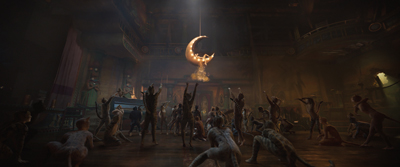 Skimbleshanks the Railway Cat
Skimbleshanks the Railway Cat
Steven McRae
Skimbleshanks the Railway Cat is the energetic watchman of the Midnight Mail, the train that runs from London to Scotland. He's protective of the younger kittens, watching out for them and shielding them from danger. He's also cheerful and playful and delivers an epic tap dance performance that leads the tribe into the railway station while he performs his signature song.
To play him, Hooper cast Royal Ballet principal dancer Steven McRae, who, like Francesca Hayward, had never sung professionally before. It was all part of Hooper's ambition to transform his cast all into triple-threat performers. "Pushing a dancer to be a singer, pushing a Steven McCrae, Prince Royal Ballet, to sing and act, that to me was the thrill," Hooper says. "I think it creates a very exciting working atmosphere."
Mungojerrie & Rumpleteazer
Danny Collins & Naoimh Morgan
Mungojerrie and Rumpleteazer are the mischievous, naughty Jellicle cats of the tribe, played, respectively, by the Sky One series' Curfew's Danny Collins and Naoimh Morgan, in her film debut. "Dancing is always evolving," Collins says. "There are always choreographers who try to push boundaries and make the choreography more thought-provoking. So, it didn't surprise me that a project like Cats could be transformed into something new and innovative, yet timeless at the same time."
Morgan agrees with her co-star: "Dance is constantly changing," Morgan says. "If you think back to years ago, hip-hop wasn't really a style. Now I'd say it's one of the most influential genres of dance there is. There's no limit to what your body can do, so it only makes sense to discover new genres and different art forms within dance. In this film, we show the audience how much dance has evolved, without erasing the forms from the original stage show. Instead, we have revived the dances, which gives the audience a taste of everything."
Working with Andy Blankenbuehler proved to be both productive and fun in finding the quirks in their characters. "My favorite parts of working with Andy were the sessions we did for Mungojerrie and Rumpleteazer," Collins says. "We would be in the smaller studio and he would throw little phrases of movement at us that he'd been working on. Sometimes he'd even make it up on the spot. There are many styles of dance throughout Cats, but these sessions were all about Mung and Rump's movement language. It felt like we were all on the same page immediately, and it's magic when that happens, because up until that point, we had been developing the characters separately. Andy's style was perfectly whippy, cheeky and characterful, and matched the devious nature of the duo." Morgan adds: "Mungojerrie and Rumpleteazer mirror each other's moves in the film. When we were rehearsing, it was quite shocking to see how similarly Danny and I interpreted how we thought a cat would move."
Alonzo
Bluey Robinson
Alonzo, who is brought to the screen by rising-star singer Bluey Robinson, is a bit of a distant cat. But that wasn't always the case. "My character, Alonzo, developed throughout the weeks that we had cat school," Robinson says. "We spent time at cat school feeling out our characters and the way that we would move as cats, and we established Alonzo as a standoffish cat who watches others from afar. He's a protector of his clan. He's had some tough times but has found his home amongst the Jellicle tribe and has a lot of love for them."
Robinson is first and foremost a singer and songwriter, but he knew that he would be dancing in this film, too. "I had less dance experience than many of the others, so I essentially had a crash course during production," Robinson says. "It felt like I had three years of training over the six-month period, and by the end, I got to a point where I started to love it. Dancing helped me to bond with everyone on set because I was able to freely express myself without any judgement."
Despite the fact that he didn't have a lot of dance experience going in, Robinson agrees that the various different talents of his castmates helped create the most well-rounded cast. "Everyone in the cast had different strengths," Robinson says. "My strength going into the project was singing, but some people had dancing backgrounds. It was interesting to see everyone come out of their shells and push themselves in areas that they weren't as proficient at as others."
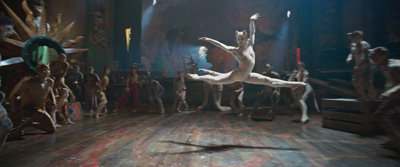 The Choreography And Movement
The Choreography And Movement
From Hamilton to The Heaviside Layer
Andy Blankenbuehler Signs On
"Directing Cats is like directing a group of world class athletes," Tom Hooper says. "The film is a celebration of what these dancers can do in terms of their physique and physical vocabulary."
Dance is as intrinsic to Cats as the music itself, conveying character and story through emotional layers, rhythmic beats and style, and guiding the cast through the intricacies was three-time Tony Award winner Andy Blankenbuehler.
"With Hamilton, Andy re-invented musical through the prism of hip-hop," Hooper says. "So, the fundamental insight was that you could see a period of history through a modern vernacular. Andy brings that modern sensibility of hip-hop and street dance into the language of Cats."
Making matters even better, Blankenbuehler also had a history with "Cats," having choreographed the Broadway revival some years earlier, and his love of Andrew Lloyd Webber's work, and "Cats," started long before that. "I got my first Cats cassette tape about five years before I saw the show in the Broadway theater," Blankenbuehler says. "I had an image in my head of what I thought it would look like, so it was interesting to see some things that I had envisioned and some things that were completely different. The magic of theater is that it sends your imagination to places you didn't even know it could go, and I try to do the same thing in my choreography. I try to create tableaus that make the mind and the heart wander."
His love of dance started at an early age, which stood him in good stead for what was to come on Cats. "I watched many film musicals as a kid, and I specifically remember the way the camera would pan on the dancers flying past or the ways the camera would shoot the dancers from high above or through architecture," Andy Blankenbuehler says. "Seeing that really made an impression on me, and although I initially went into stage dancing, I've always thought stage dance and film dance walk hand in hand."
What Blankenbuehler loved about the original musical was the way in which the show's choreographer Gillian Lynne had used contemporary and modern dance moves to convey story. "The original Cats musical is in a category of its own," Blankenbuehler says. "It's a wonder and a novelty. I love that the dancing was both literal storytelling and at times totally abstract."
Adapting it for the screen would be an extraordinary opportunity, and an extraordinary challenge. "I knew that this film would be a titanic feat," Blankenbuehler says. "I prepared by getting to know the score and the characters inside and out."
With so many dance numbers and more than 50 performers to choreograph, Blankenbuehler kept his movement pallet broad, embracing that sense of heightened reality that Cats demanded. Hooper and he wanted to embrace an expanse of dance styles, from tap to hip hop, street dance to ballet.
"The dancers did a great job staying disciplined and pacing themselves," Blankenbuehler says. "They understood that any take could make it into the film. They couldn't just perform a great routine once. They had to do it many times, and they had to bring an intellect to the routine to make sure that their physicality really meant something."
Each dancer brings to the table a very different set of skills, which required different choreographed approaches. "I adjusted the choreography to cater to each person's individual strengths," Blankenbuehler says. "For example, in an instance when the music flew high, I made sure that a tumbler who could go high was in the foreground of that shot."
Although he and the cast were working across a variety of dance genres, he made sure to stay connected to the feline. "There were instances when I would get caught up with figuring out what the perfect physical interpretations were for the story, but then I would take a step back and think, 'Oh, wait. These are cats. What would a cat do in this situation?'" Blankenbuehler says. "It was helpful for me to keep going back to that question. Some of the most beautiful moments were when we would commit to cat-like physicality and take away the traditional dance step completely."
Finding Your Inner Feline
The Cast Goes to Cat School
Before filming got underway, every member of cast had to learn the physical language of the feline, attending the appropriately named Cat School under the tutelage of cat movement choreographer Sarah Dowling. Each week the actors/dancers would study the physical behaviour and movements of real cats and, in group sessions, work together to find their inner cat, channeling the emotional and psychological behaviour of their character into feline movement. "The whole fun of the film is that it is humans playing cats," Hooper says. "By doing it this way, we were going to see some of the best dancers in the world interpret how to be a cat."
For Dowling, the process was about each performer finding the movements that best suited their feline character. "There's a great mix of dance styles in this film," Dowling says. "Rather than trying to make a generic version of the cats, I aimed to bring out the individual rhythm and physicality of each character in the way I trained them to move. We spent weeks in the studio investigating each person's individual dance style. The rules of being a cat were constantly shifting and needed to be malleable to the requirements of the specific performers."
The cast found the classes invaluable in creating their characters and entering a feline mindset. In fact, some of them, perhaps, got a little too into it? "We had cat school at the studio on set, but I was much more committed than that," James Corden says, laughing. "I lived as a cat for about eight weeks when I was gearing up to shoot the film. I had a litter tray next to my bed, a big scratch pole in my office and I employed a couple people with laser pens just so I could follow them everywhere."
The Music
From Stage to Screen
Adapting Cats' Legendary Songs for Film
T.S. Eliot may have written the source material for Cats, but Andrew Lloyd Webber breathed life into Eliot's words with music, resurrecting his poems by elevating them in a musical that has become beloved by legions of fans around the globe. Maintaining the integrity of the music was crucial to the success of its adaptation to screen. "We are staying true to the brilliant music Andrew Lloyd Webber wrote, this extraordinary score which I still think is one of his best," Hooper says. "Andrew has this incredible combination of an incredibly gifted and strong sense of melody, a melody that's very accessible to the widest audience, and yet, he wants to avoid cliché, wants to surprise, wants to push the boundaries. You look back at the score he created, and his use of electronic music in 1981, and it's groundbreaking. In some ways, it's still ahead of its time."
Lloyd Webber himself produced the film's score, and was joined by Grammy-winning musician, songwriter and record producer Greg Wells, who has written and produced with Adele, Rufus Wainwright, Pharrell Williams, among others, and who, along with Lloyd Webber and Hooper, produced Taylor Swift's version of the film's new song, "Beautiful Ghosts." Legendary music producer, Grammy winner and Rock & Roll Hall of Fame inductee Nile Rodgers came on board to work on the tracks "Rum Tum Tugger", "Macavity" and "The Jellicle Ball." The goal was to maintain the integrity of the music, but also make it feel fresh and new again. "We were faced with the challenge of figuring out how to approach the music from a contemporary perspective while also preserving the original," producer Eric Fellner says.
The live on-set recordings were overseen by Marius De Vries (La La Land, Moulin Rouge), who has been behind some of the most culture-defining recordings and soundtracks of the past three decades, and associate music producer David Wilson, who also worked with Lloyd Webber on the orchestrations.
Prior to filming, the cast worked with de Vries and Wilson to help prepare for their performances. "The fundamental chemistry of filmed performance is the relationship between the director and performer," de Vries says. "My goal was to manage the music without having to insert myself unduly during the filming process, so it was important for me to spend time with each of the cast members beforehand and thoroughly figure out where they needed any particular guidance or explanations or where we needed to adapt the music to fit each actor's individual talents. In some cases, the process took many weeks of intense vocal training and rehearsal, and in others, there was very little vocal training or rehearsal at all, more just discussion and an examination of intentions. In every case, I tried to set the machine up as well as I could and then let it roll."
A New Song
"Beautiful Ghosts"
Because Tom Hooper had expanded the role of Victoria for the film, the character was given her own signature song, "Beautiful Ghosts," which was written by Taylor Swift and Andrew Lloyd Webber. For Hooper, hearing Lloyd Webber's music and Swift's lyrics for the first time was a powerful experience. "It was as if someone had come into our world we were creating and then wrote these lyrics that distilled back to me the essence of what Lee Hall and I were trying to say with this character," Hooper says.
Performed by Francesca Hayward in the film, "Beautiful Ghosts" is also performed by Swift in a version that plays over the film's end credits. For Hayward, the song ideally captured Victoria's journey. "'Beautiful Ghosts' is a song that Victoria sings to Grizabella," Francesca Hayward says. "It's Victoria's way of trying to connect with her and pull her out of her pain and misery. There's also a lovely part of the song where Victoria finds strength in herself, too. She sees the beauty in what she's found in the new friendships she has with the Jellicle cats. I had never really sung in public before this film. To be in the same room as Andrew Lloyd Webber and to be coached by him was extraordinary. I think every generation should grow up with his music, which is incredibly powerful and beautiful."
Finding Their Voices
Cast Vocal Training
The cast spent many months in vocal training preparing for their roles, which would involve singing while performing intensive dance moves, often for 11 shooting hours a day, over a period of three months. Vocal coach Fiona Grace McDougal had worked on many of Lloyd Webber's stage shows and helped prepare the cast for the vocal equivalent of a marathon.
"The difference between stage and film is going from performing the song once or twice in a day to suddenly performing it over and over again and that can be really demanding on the voice," McDougal says. She focused on helping the actors build up vocal strength and stamina, and helped them master their own voices. Just as important, she gave them the confidence to take on some of the most iconic songs in musical theater. "She's just phenomenal," Judi Dench says. "She makes you think you are Callas."
Mixing It Up
The Live Sound of Cats
From the first frame of Cats until the very last, the actors are singing, and just as Hooper had achieved with Les Misérables, singing live. Unlike with Les Mis, the actors are also dancing. "Every single day on Cats was bigger than our biggest day on Les Mis because of the dancing element," says production sound mixer Simon Hayes, who won an Oscar® for his work on Les Mis. "We also had live percussion to keep the dancers in rhythm. On Les Mis we only had a live piano."
To capture the live performances, both the percussionist and pianist were performing in separate booths close to the stage. Their sound fed to Hayes, who fed it to the actors through bespoke in-ear monitors (IEMs), custom made to fit each actor's ear canal so the devices didn't fall out while the actor was dancing. The microphones were incorporated into the headpiece of the actor's motion-capture suit, sitting discreetly on their forehead, to capture their vocals. A transmitter on each of the actors then transmitted the sound from their mic to Hayes. Done this way, Hayes and his team could record the vocals clean. Only Hayes and the actors could hear the music. Everyone else on set could only hear the actor's vocals.
Recording the music live in this way gives the actors complete freedom and control over the performance of the song. It also allowed spontaneity, which is vital to achieving great performances. The emotion of the song matched the emotion of their actions. "They don't have a point when they have to sing," Hayes explains. "They can choose their timing based on the decisions they are making as an actor rather than predetermined decisions that have been made by a recording track that they are hearing in their ear. When they decide to sing a line, the piano will accompany them, not the other way around."
As for how to deal with the background sound of dancers moving across the stage while someone is singing, Hooper and team decided to embrace it. "Tom wanted to celebrate elements of the noise that we encounter along the way," Hayes says. "He feels that there's always an emotion within the on-set noise as long as that noise is real to the performance we are filming. When we hear an actor out of breath from a dance routine there is a reality that the audience will be able to connect with because they will know what they are watching is real."
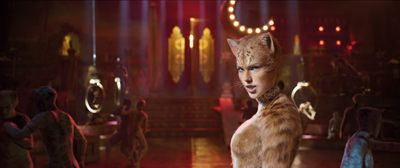 The Visual Effects
The Visual Effects
Alive and High-Kicking
Creating the Cats
Long before the first character was cast or the first set built, the filmmakers needed to create a new look for the cats themselves. The stage musical was of its time"big makeup, big hair, ʼ80s-style costumes"but what worked for stage would not work for 21st century cinema. Early on, Hooper began working on options with his longtime production designer Eve Stewart, who had first collaborated with Hooper on the 2005 miniseries Elizabeth I and has worked with Hooper on all his films since. "What's fantastic about Eve is she's a great world creator," Hooper says. "She got involved right at the beginning in designing the cats. Before we had any knowledge of how we could create them, she was doing these incredible evocative images that caught the fun, the humor, the pathos, the sadness, the drama of these characters."
Hooper and Stewart often seem to almost be able to read each other's minds. "Tom and I make a great team," Stewart says. "He's extraordinary at making decisions and I'm a prolific presenter. When I had 32 ideas per minute, I needed someone who would say, 'That's the one.' It was a great combination of exuberance and exactitude."
Hooper had established some firm guide rails, producer Debra Hayward says. "Tom absolutely knew he wanted to catch the live-performance aspect," Hayward says. "He did not want it to be a computer-generated version of Cats." The actors also had to be able to dance and move as cats at all times, and Hooper wanted that done through performance, not via technology. "He did not want to cross that line into something that could be achieved in visual effects," Hayward says.
The team looked at how they could employ costumes, makeup and prosthetics, but realised that with the actors and dancers in motion most of the time, makeup would run and costumes and prosthetics would hinder movement. Luckily, technological leaps in visual effects and motion capture would assist Hooper in turning his vision for the cats into a reality.
During the shoot, Academy Award®-winning Visual Effects Supervisor Steve Preeg and VFX producer Rupert Smith spearheaded the team that would find a path through the technical complexities to achieve the desired effect. Hooper wanted to keep as much of the actors' faces and all their facial expressions untouched as well as their hands and feet. To create these cat characters on screen, Preeg and his team needed to create a hybrid technology that blended the real with the animated.
In post-production, the VFX team was expanded to include Phil Brennan, Jason Billington and Matt Jacobs, who oversaw many hundreds of artists from several continents. They worked together to create the final look of the cats and the incredible environments in which they perform.
The Make Up
No Line Out of Place
Intense Precision and Craft
While visual effects supervisor Steve Preeg and his team advanced the tech, the actual design of the cats fell to the costume, makeup and production design departments, and Preeg worked closely with those creative leads as the looks were developed. Makeup designer Sharon Martin (Okja, Snow White and the Huntsman) and her team worked on eyes and mouth, as well as skin tone, which would always be in-camera. It was an exacting process. "When we were shown the concept art, I had conversations with Tom and the VFX team about the specific details that we needed for each character," Martin says. "The makeup helps the VFX team establish subtleties in facial movements and textures of the skin. Tom was very keen on the precision of the makeup and the emotions that he knew it would help portray."
One line or dot out of place and it would impact on the VFX team's ability to do their job. "We put patterns onto the faces of the various cats," Martin recalls. "The lines on their faces were extremely precise and needed to be in the exact same spot every day, so we had masks made which we cut the patterns into and were able to use these as a reference guide."
The Costumes
Dressing Digital Fur
The Art of Clothing Cats
Only a handful of characters in Cats were given actual costumes, including Old Deuteronomy, Mr. Mistoffelees, Grizabella, Gus the Theatre Cat, Bustopher Jones, Macavity, Jennyanydots and Rum Tum Tugger. "This isn't the traditional film in which all of the characters have costumes," says costume designer Paco Delgado, who had previously worked with Tom Hooper on The Danish Girl and Les Mis. "Tom and I had conversations early on about which characters would have costumes and which would only wear collars. We also worked closely with the VFX department on the costumes and on the design of the suits that the performers wore. We also made sure that the costumes were an extension of each of the cat's fur."
Delgado had to redesign the Xsens motion-capture suits the actors wore to make sure that the sensor casings were not too rigid and could function with the range of movement of high-energy dance. "It was a new adventure into a VFX world," Delgado says. "We had to discuss what elements needed to be in the costumes to record movements. It was very technical. We started making prototypes with the guidance of the VFX team until we found the closest suit to perfection."
Each suit was custom-made for each performer, using soft, thin Lycra for comfort and flexibility, and yet because the suits needed to carry a lot of information, the costume team had to work the sensors, wiring and battery packs into the body suits in such a way as to not impede the movements of the actors and dancers.
The costume team worked with the Royal Ballet to reconceive the suits, making seven or eight versions until they arrived at a suit that met technical requirements and allowed the dancers full flexibility.
The Production Design
Large and In Charge
Creating the 1930s London of Cats "One of the truly magical things about this as a movie is you walk on the sets and you are transported, scaling the world up around our cats, where the world becomes unfathomably large," Tom Hooper says. Cats takes place over one night in 1930s central London. From the moment Victoria is abandoned in the Wasteland, the audience is taken on a whirlwind ride through dark graveyards, rubbish-strewn back alleys, a domestic kitchen, a neon-lit Milk Bar, a decrepit theatre and eventually to Piccadilly Circus. "Tom was keen from the beginning to honour the world that T.S. Eliot created in these poems, and that's what we tried to do in the film," says Debra Hayward. Production designer Eve Stewart sought to capture the London that Eliot would have been seeing in the 1930s as he was writing his Old Possum's Book of Practical Cats. "Very early on, Eve began to do these incredible renderings of the world, night skies with all these pinks and mauves and purples and inspired by the idea of Soho"colored neons flooding into the misty London 1930s sky," Hooper says. "Her process starts with this extraordinary artwork that she creates that ends up inspiring me and inspiring the team."
Working with Hooper inspired her, too. "Tom and I initially thought about the time that the film takes place," Stewart says. "It's set roughly around the year that T.S. Eliot published Old Possum's Book of Practical Cats, so we really wanted to capture the look of the middle of London in the late 1930s."
Cats is Stewart's sixth film with Hooper, and the success of their working relationship lies in a mutual desire to immerse themselves in the lives of the film's characters. "In the beginning, I drew every single scene, so we could discuss them," Stewart says. "I would also make very detailed, colored models so everyone knew what we were aiming for early on." Stewart believes it is vital for filmmakers to be able to live and breathe the world she creates for them and that is never more evident than in the sets she has designed for Cats. "Eve always brings such a strong sense of realism to the worlds she creates," Hooper says. "And in this case, she balanced that with the wit, the humor and the scale of what we were planning, balancing the magic with a sense of grit and decay."
Designed from a cats-eye view, so that the human actors appear to be the size of actual house cats, Stewart's set"the sheer scale of them"is nothing short of breath-taking. Everything has been magnified and scaled up to extraordinary proportions.
"We spent a long time trying to work out what the scale of our world was," Debra Hayward says. "We did a lot of research into how big cats were versus the human world and we arrived at this ratio of around two-and-a-half to one."
With some exceptions, Stewart says. "The sizes of the set pieces all varied in scale," Stewart says. "Every single thing on set had to be made from scratch, and while the size of some objects were multiplied by three, other things didn't look believable at that size. For example, the chairs had to be three times their normal size, to give the cats something to jump up onto. But we quickly learned that certain things, such as bricks, didn't look realistic at that scale. It was an ongoing process of adjusting every small detail until it was just right."
As fantastic and theatrical as the world of Cats is, it's grounded in reality. The main street in the film is Soho's Meard Street, and the dance hall is a re-creation of what once was a small theater for magicians behind Piccadilly: the Trafalgar Square Lion. "We talked about Eliot's great Wasteland and this idea that, between the wars, London's music halls were sort of dying out and falling apart," Hooper says. "That slightly dilapidated version of London we felt would give cats even more freedom to roam the night."
Designing for Sound and Dance
Solving Technical Challenges
Creating a very real giant world"no digital green screen was invoved in the shooting of this movie"was a major undertaking, made all the more challenging because the construction of every set had to be able to accommodate live singing and dancing. The sets had to be designed and built to minimize sound, be strong enough to accommodate 50 dancers cavorting across them at any one time, and yet have sufficient bounce for some feline acrobatics. It was an immense challenge as they had no idea when they were building the sets exactly where on them the dance numbers would be taking place.
"One of the biggest hurdles for the design and construction of the set pieces was that we didn't know exactly where the cats were going to go," Stewart says. "We had some of the best dancers in the world and they were constantly moving around the sets, so we had to make sure that every surface, every pipe going up the wall, every door knob, handle and drawer was able to safely hold the weight of the dancers." Adding to Eve Stewart's pressure, every last prop had to be custom-made"every fork, table, chair, cushion, bowl, telephone. You name it, they made it.
The Cinematography
Multi-Camera Mastery
Shooting Cats
Filming massive sets, gigantic live production numbers and a huge cast required a director of photography skilled at tackling all of that and more. Luckily, Christopher Ross had recently shot Yesterday, which saw him working with live-performance singing to crowds of 6,000 people. Together, Ross and Hooper devised a plan for how to film the world of Cats. "The combination of dance routines, vocal numbers and young Victoria's journey all collide in this story," Ross says. "I wanted to show the balletic routines with great grace, the vast chorus numbers with huge scale and the softer vocal moments with visceral intimacy. During intimate or confrontational moments, we shifted to use handheld photography. When you're making a straightforward drama, the locations you inhabit and the story you tell tends to be relatively linear. Whereas, in the musical form, you can take huge leaps in one direction or another. I really enjoyed that ability to experiment visually."
In addition, Ross adjusted his shooting style for individual musical numbers and sets. "Mungojerrie and Rumpleteazer's scene in the bedroom has a staccato, jazz-like rhythm to it, which lent itself to more cuts to amplify these moments of thievery, which those characters are prone to," Ross says.
The film takes place entirely over one night, from dusk until dawn. Each song is written in a slightly different style and features a different set of characters and locations. "We used Victoria's story and the choreography to guide us as to where to place and how to use the camera," Ross says. "I broke down how we wanted each environment to feel and then worked out how to bring the light from that environment onto the characters, who pass in and out of the lights and shadows."
Ross and Hooper had to work closely with the choreography team to make sure the environments were lit to show off the dance to maximum effect. "We had to not only focus on the atmospherics of the scenes, but on the silhouettes, highlights, sidelights and cross lights, particularly during the dance routines," Ross says. "Some movement looks better in a silhouette, while others look better side-lit."
And, of course, London itself proved a principal creative touchstone. "When I became involved in the project, the production designer, Eve Stewart, and Tom Hooper had already had many conversations about the visualization, settings and scale of the film," Ross says. "Setting this film in 1930s London helped make this a more visceral, real story. Our sets were infused with various colors, which we let influence our visual storytelling."
To emphasize the scale and perspective of the sets, and the cats within those sets, Ross worked with different scales. "We had to be mindful of continuously paying attention to the fact that our human-sized performers were to be visually scaled down to the size of cats," Ross says. "In order to keep this consistent, we made sure to constantly have an object like a trashcan, a curb or a doorframe somewhere in the shot at all times. When the viewer sees how large those items are next to the performers, it reminds them about the geometry of the environment."
He also found inspiration in some unexpected places. "We looked at films like Toy Story and Wall-E for ideas on how to constantly remind the audience of the scale," Ross says.
Because of the scale of the production numbers and sets, Ross had to be vigilant about framing and lighting, especially on the actors' faces. "From a technical perspective, if you try to light a dance routine from any closer than 30 feet from the dancers you run out of dance floor very quickly," Ross says. "So, since the game plan was to give the dancers the whole floor, I needed to figure out how to create an atmosphere where the audience falls in love with the character while also allowing the dancers space to shine."
As with all aspects of Cats, the ambition was always to stay focused on the story and the characters. "From a cinematography perspective, the greatest complexity was in telling the story and not letting the VFX side of things get in the way or overshadow what Tom was trying to achieve with performance," Ross says. "In order to do this, we worked on a shot by shot basis, trying to achieve the cleanest outline of the dancers with minimal infringement, but knowing that infringement was inevitable in pursuit of capturing the most evocative performance."
The History Of "Cats" The Stage Musical
Throughout the history of stage and screen, great works of literature have been re-interpreted for new audiences, the baton being passed down through generations of writers, directors, performers, as they present their vision of stories that that have shaped our cultural lives. Novels such as Bram Stoker's Dracula, C.S. Lewis' Alice in Wonderland, Jane Austen's Pride & Prejudice, Tolstoy's War and Peace, and poems such as Beowulf, The Wallace and Homer's The Odyssey have all found their way onto stage and screen, reimagined and represented. Like a musical score, they either express the mood of the times we are living in or bring something more personal to bear for the artists who are re-interpreting it. Old Possum's Book of Practical Cats by T.S. Eliot is no exception.
First published in 1939, Old Possum's Book of Practical Cats brings together a collection of poems that Eliot wrote to his godchildren between 1934–35, and in which he describes the lives of cats as told through extraordinary feline characters such as Gumbie Cat, Old Deuteronomy, Macavity, Bustopher Jones and of course the Jellicle cats. The poems were never intended for a book. Rather, each poem was a gift to the children in his family. Incidentally "Old Possum" was Eliot's pseudonym, affectionately coined by his close friend and fellow poet Ezra Pound.
The poems' potential for music was first recognized in 1954 when composer Alan Rawsthorne presented a work for speaker and orchestra titled Practical Cats. However, it was Andrew Lloyd Webber's adaptation of the poems for musical stage that turned the poems into the global phenomenon they are today.
After premiering his initial compositions at Sydmonton in 1980, Lloyd Webber was presented by Eliot's widow Valerie Eliot with a set of unpublished poems that included Grizabella the Glamour cat.
Although originally penned for children, Eliot thought Grizabella's story too sad to publish in a children's book. Lloyd Webber immediately saw the narrative potential that her story presented. Grizabella's tragedy added depth to the whimsical world of Old Possum's cats and paved the way for Lloyd Webber to turn the collection of poems into a stage musical.
The stage show is set among a larger-than-life junkyard playground, the Wasteland, and is alive with what have become globally famous feline characters including The Rum Tum Tugger, Mr. Mistoffelees, Macavity, Jennyanydots, Old Deuteronomy, Grizabella and Skimbleshanks.
The story is based around a group of cats called the Jellicles who, on one special night of the year, vie for the attentions of their wise leader Old Deuteronomy, every cat telling their story in the hope that they will be chosen to ascend to The Heaviside Layer and be reborn into a new Jellicle life.
Beyond theater, Cats' show-stopping song "Memory" has been recorded by more than 150 artists from Barbra Streisand and Johnny Mathis to Liberace and Barry Manilow. Both the original London and Broadway cast recordings won Grammy Awards for Best Cast Album. Cats has gone on to spawn an industry in the world of entertainment, but unlike other great musicals"e.g. West Side Story, Les Misérables, Evita"it had yet to be adapted for film…until now.
Thirty-eight years after Cats the musical first premiered at New London Theatre in Covent Garden, Tom Hooper reimagines Lloyd Webber's masterwork work for the screen.
Release Date: December 26th, 2019
MORE


